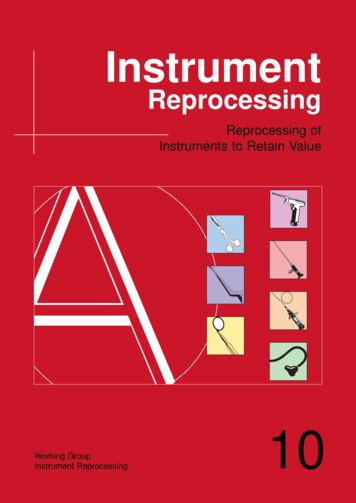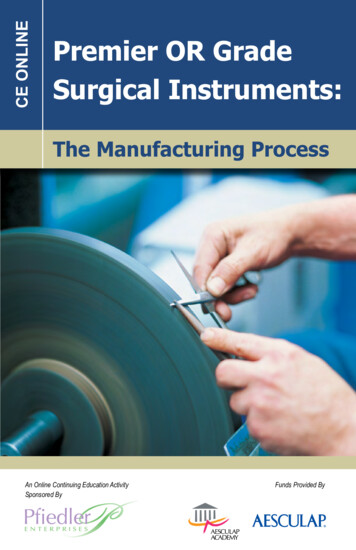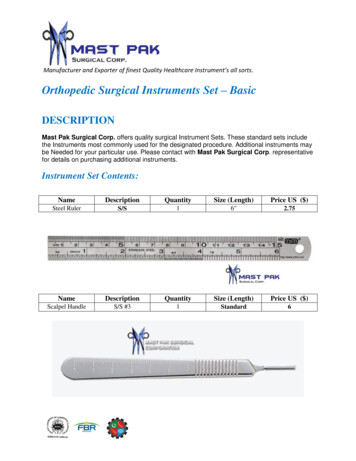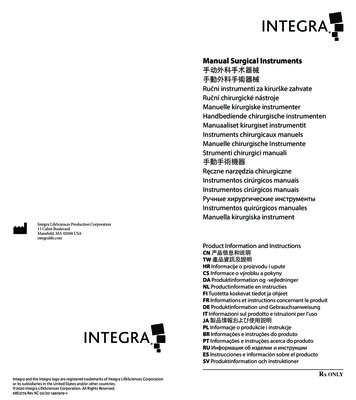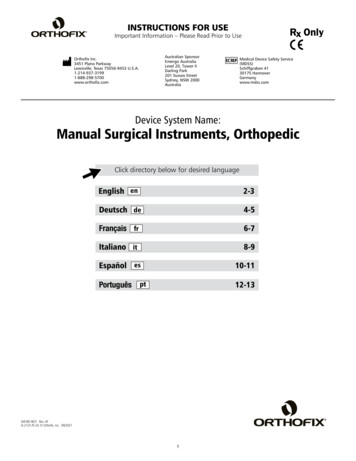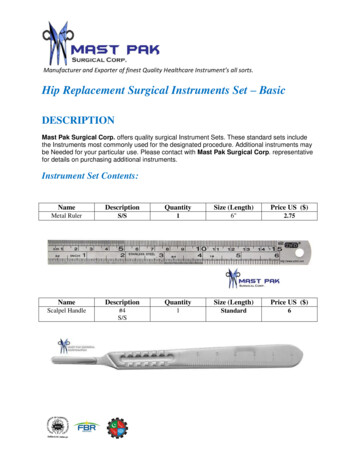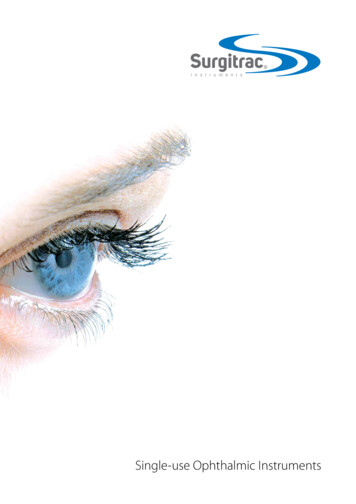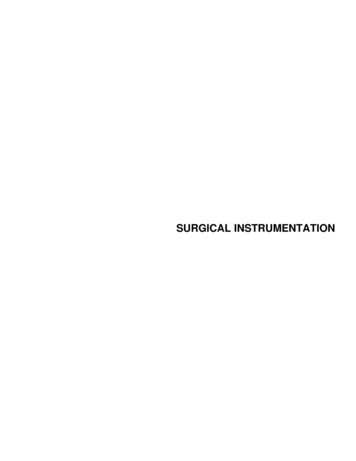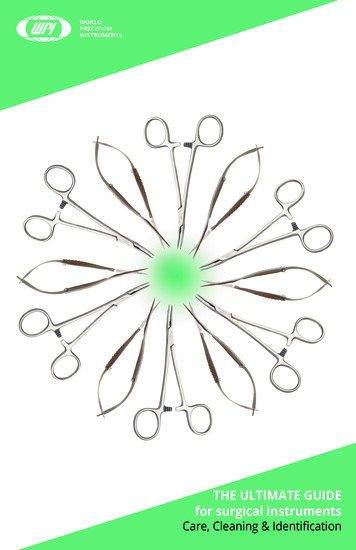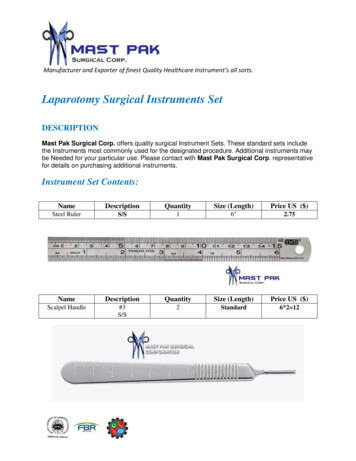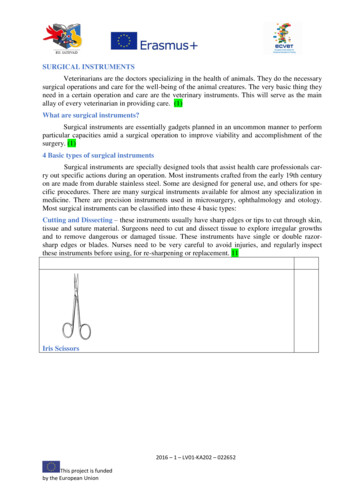
Transcription
SURGICAL INSTRUMENTSVeterinarians are the doctors specializing in the health of animals. They do the necessarysurgical operations and care for the well-being of the animal creatures. The very basic thing theyneed in a certain operation and care are the veterinary instruments. This will serve as the mainallay of every veterinarian in providing care. (1)What are surgical instruments?Surgical instruments are essentially gadgets planned in an uncommon manner to performparticular capacities amid a surgical operation to improve viability and accomplishment of thesurgery. (1)4 Basic types of surgical instrumentsSurgical instruments are specially designed tools that assist health care professionals carry out specific actions during an operation. Most instruments crafted from the early 19th centuryon are made from durable stainless steel. Some are designed for general use, and others for specific procedures. There are many surgical instruments available for almost any specialization inmedicine. There are precision instruments used in microsurgery, ophthalmology and otology.Most surgical instruments can be classified into these 4 basic types:Cutting and Dissecting – these instruments usually have sharp edges or tips to cut through skin,tissue and suture material. Surgeons need to cut and dissect tissue to explore irregular growthsand to remove dangerous or damaged tissue. These instruments have single or double razorsharp edges or blades. Nurses need to be very careful to avoid injuries, and regularly inspectthese instruments before using, for re-sharpening or replacement. 11Iris Scissors2016 – 1 – LV01-KA202 – 022652This project is fundedby the European Union
Clamping and Occluding – are used in many surgical procedures for compressing blood vesselsor hollow organs, to prevent their contents from leaking. Occlude means to close or shut. Therefore, these instruments are also used to control bleeding. They are straight, curved or angled, andhave a variety of inner jaw patterns. Haemostats and mosquito forceps are some examples ofthese types of instruments. 11Crile Haemostatic ForcepsRetracting and Exposing – these surgical instruments are used to hold back, or retract organsand tissue so the surgeon has access to the operative area. They spread open the skin, ribs andother tissue; and are also used separate the edges of a surgical incision. Some retracting and exposing instruments are “self-retaining,” meaning they stay open on their own. Others manualstyles need to be held open by hand.11Volkman Retractor2016 – 1 – LV01-KA202 – 022652This project is fundedby the European Union
Grasping and Holding – these instruments, as their name suggests, are used to grasp and holdtissue or blood vessels that may be in the way during a surgical procedure. Medical assistantsmust make sure these instruments are working correctly, and that their locking mechanisms arelubricated for easy opening and closing, particularly after cleaning and reprocessing. Forceps area very good example of these types of instruments.11Allis Tissue ForcepsPerform surgical procedures. Chosen based on action. These tools are used for: Holding Pulling Clamping Cutting Crushing Closing a woundDefinitionsExcision – removal of tissues by surgical cuts.Ecraseur – an instrument that permits excision by a crushing action.Incision – surgical cut made into a tissue of organ.Cannula – a tube that is inserted into a body cavity for drainage of fluid. (2)ForcepsForceps are a surgical instrument that resembles a pair of tongs and can be used in surgery for grabbing, manoeuvring, or removing various things within or from the body.[3]For skin closure use a fine-toothed forceps, such as an Adson forceps. The forceps shouldbe held so one arm is an extension of thumb and the other is an extension of your index finger.The base of the forceps should rest on the dorsal surface of the web space between the thumband index finger.2016 – 1 – LV01-KA202 – 022652This project is fundedby the European Union
Use only forceps with teeth. Use the arm with a single tooth to gently elevate the skinedge. Avoid crushing the skin edges with the forceps. This further traumatizes the wound edgeand impedes healing.The forceps allow you to create counter traction and control the position of the skin edge to facilitate passage of the needle perpendicularly through the skin. The forceps should also be used tograsp the needle when repositioning it in the needle holder. You should never touch the needlewith your fingers.13Forceps are three types:-thumb forceps for holding tissue with the left hand while using another instrument in the righthand (or vice versa for the sinistral surgeon). They are called also tissue forceps. (1)-Clamping forceps a forceps – like clamp with an automatic lock, for compressing arteries, etc.(1)Depending on their function, basic surgical forceps can be categorized into the following groups:non disposable forceps, disposable forceps, thump forceps.-Needle holders, hemostat – like devices that hold needles used to suture wounds closed. (2)Needle holders play vital role in the performance of surgical operation involving human and animals. However, in animals there are special types of needle holders. These are classified andidentified based on their usage, the animals being operated, as well as other important contributing factors (1).Needle holderA needle holder, also called needle driver, is a surgical instrument, similar to a hemostat,used by doctors and surgeons to hold a suturing needle for closing wounds during suturing andsurgical procedures.15The parts of a simple needle holder are the jaws, the joint and the handles. Most needleholders also have a clamp mechanism that locks the needle in place, allowing the user to manoeuvre the needle through various tissues. To maintain a firm grip on the needle, the jaws areoften textured and short compared to the handles (increasing the applied force following theprinciple of a lever).7There are several techniques for holding the needle holder. The most common method isto place the thumb and ring finger slightly into the instrument’s rings. This allows you to pronate2016 – 1 – LV01-KA202 – 022652This project is fundedby the European Union
and supinate and to open and close the jaws of the needle holder. Avoid inserting your fingers farinto the rings of the instrument, since this will tie up your fingers and impede your mobility.Some surgeons do not put their fingers into the rings at all and simply grasp the rings and bodyof the needle holder in the palm of their hand.13A Mayo-Hegar Olsena needle holder2016 – 1 – LV01-KA202 – 022652This project is fundedby the European Union
Coordinated use of the forceps and needle holder:Efficient and atraumatic placement of sutures which follow the rectangular pathdescribed above requires coordinated use of the forceps and needle holder. One can best takeadvantage of the natural curvature of the needle by alternately pronating and supinating thehand with the needle holder. 13Needles: permanently attached suture material swaged – on. Tip may be blunt, tapered,Sharp, cutting, or some other configuration.Most sutures come as a single piece, with the suture material swaged onto the base of theneedle. The needle should be grasped in the tip of the needle holder about 2/3 of the way backfrom the point. Grasping further back at the swaged end tends to weaken the needle and its attachment to the suture, and you are likely to bend the needle.There are many different needle types, but the chief distinction to be made here is the difference between taper or “smooth” needles in contrast to cutting needles. Taper needles do justwhat their name implies: they gradually taper to the point, and a cross-section anywhere alongthe shaft would reveal a round shaft, as shown in the inset. Taper needles are used for tissue thatis easy to penetrate, such as bowel or blood vessels. 13In contrast, the tip of cutting needles is triangular in shape, and the apex forms a cuttingsurface, which facilitates penetration of tough tissue, such as skin. Cutting needles make it mucheasier to penetrate tough tissue. Penetrating skin with a taper needle is very difficult and causesexcess trauma to the skin because of difficulty in penetration and the need to grasp the skin edgevery tightly with forceps. Consequently, you should never use taper needles to suture skin.2016 – 1 – LV01-KA202 – 022652This project is fundedby the European Union
The reverse cutting needle is similar to a conventional cutting needle, except that the cuttingedge faces down instead of up. This may decrease the likelihood of sutures pulling through tissuein some cases. 13Scalpel handle and bladesA scalpel, or lancet, is a small and extremely sharp bladed instrument used for surgery,anatomical dissectionSurgical scalpels consist of two parts, a blade and a handle. The handles are often reusable, withthe blades being replaceable. In medical applications, each blade is only used once (even if justfor a single, small cut).(5)10 size blade most popular, 11 has a straight edge and sharp point. 15 has a very small cuttingedge, used for fine, delicate surgery (e.g. eye). 20 is similar to 10 but larger.7 handle with 15 blade (deep knife) – used to cut deep, delicate tissue.3 handle with 10 blade (inside knife) – used to cut superficial tissue.4 handle with 20 blade (skin knife) – used to cut skin. 1The smaller #15 blade is well suited for short, tortuous incisions; for this type of incision holdingthe scalpel as if it were a pencil may facilitate control.132016 – 1 – LV01-KA202 – 022652This project is fundedby the European Union
ScissorsScissors are sharp instrument composed of two opposing cutting blades held together bya central pin on which the blades pivot. The most common dissecting scissors are the straightMayo, for cutting sutures; the Snowden-Pencer, for deep, delicate tissue; the long curved Mayo,for deep, heavy, or tough tissue; the short curved Metzenbaum, for superficial, delicate tissue;and the long, blunt curved Metzenbaum, for deep, delicate tissue. sharp instrument composed oftwo opposing cutting blades held together by a central pin on which the blades pivot. The mostcommon dissecting scissors are the straight Mayo, for cutting sutures; the Snowden-Pencer, fordeep, delicate tissue; the long curved Mayo, for deep, heavy, or tough tissue; the short curvedMetzenbaum, for superficial, delicate tissue; and the long, blunt curved Metzenbaum, for deep,delicate tissue.8Scissors are available in various configurations like:blunt/blunt;blunt – sharp;sharp – sharp.They may also be straight or curved. Some scissors are serrated for cutting thick bandages or cartilage.1Scissors:Types – according to curvature – straight, curved or angled2016 – 1 – LV01-KA202 – 022652This project is fundedby the European Union
Use – dressing stitch removal, tissueThe Tip – sharp or bluntFour different types- Utility- Suture- Surgical- DissectingThe cutting edges of straight blades can be oriented many different ways. Standard straightblades will cut in a straight line forward and the blades move (opens and closes) in the sameplane the handles are pressed together. Blades that are angled on the edge cut in the same planein which the handles move but they are angled from the handle’s axis (point up or down). Bladesthat are angled on flat are angled from the plane of the handles (point sideways). Sure Cut scissors make a reliable, clean, smooth cut. There is less force required to cut tissue with these scissors. The bevel-honed edge of Sure Cut scissors acts like a razor edge to cut tissue withoutcrushing it. The superior sharpness guarantees that cutting is always effortless with Sure Cutscissors. 9Metzenbaum scissorshttps://youtu.be/-ADSc7C0BHMThe name Metzenbaum derives from its designer, Myron Firth Metzenbaum (1 April1876–25 Jan. 1944), an American surgeon who specialized in oral and reconstructive surgery.They are also occasionally referred to as Metzenbaum, or Metzenbaum-Lahey forceps. Metzenbaum scissors are surgical scissors designed for cutting delicate tissue. The scissors come in variable lengths and have a relatively long shank-to-blade ratio. They are constructed of tungstencarbide and blades can be curved or straight. The blade tips are blunt. This is most common inorgan operations.7Mayo scissors2016 – 1 – LV01-KA202 – 022652This project is fundedby the European Union
Mayo scissors have semi-blunt ends, a feature that distinguishes them from most othersurgical scissors. Metzenbaum scissors are, however, similar in that the ends are the same onboth scissor halves, but its handles are longer and its middle section is slightly narrower.Straight-bladed Mayo scissors are designed for cutting body tissues near the surface of awound. As straight-bladed Mayo scissors are also used for cutting sutures, they are also referredto as "suture scissors".Curved-bladed Mayo scissors allow deeper penetration into the wound than the type withstraight blades. The curved style of Mayo scissor is used to cut thick tissues such as those foundin the uterus, muscles, breast, and foot. Mayo scissors used for dissection are placed in tissuewith the tips closed. The scissors are then opened so that the tips open and spread out the tissueduring the dissection process.7Bandage scissorsor bandage forceps, are angled tip scissors, with a blunt tip on the bottom blade, whichhelps in cutting bandages without gouging the skin.Bandage scissors were invented by Henry A. Kimmel in 1961 to prevent injury when removing a tight bandage. They are very popular in any health care facility because they are designed to safely lift bandages away from skin for easy cutting. The bottom blade of the scissor islonger and goes easily under the bandages. The blunt tip design of the scissor prevents accidentalinjury while making bandage removal very easy, smooth, and quick.7Utility scissorsCut material that may dull the blade. Shears with stainless steel blades that are for cutting casts, bandages, tubing and drapes. This is for use in the anaesthesia, orthopaedics and general hospital use. There are two sizes (nr. 5.5 ; 7.5)Suture scissors2016 – 1 – LV01-KA202 – 022652This project is fundedby the European Union
https://www.youtube.com/watch?v 8As117109-cDissecting ScissorsMade from stainless steel. They come in a variety of styles and lengths:S/B - One sharp point and one blunt pointS/S - Two sharp pointsB/B - Two blunt points 15Operating scissors 152016 – 1 – LV01-KA202 – 022652This project is fundedby the European Union
4 Basic types of surgical instruments Surgical instruments are specially designed tools that assist health care professionals car-ry out specific actions during an operation. Most instruments crafted from the early 19th century on are made from durable stainless steel. Some are designed for general use, and others for spe-cific procedures .
